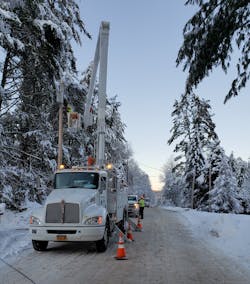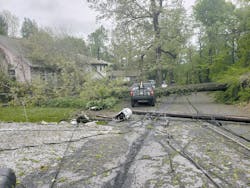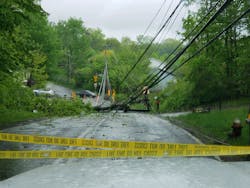Storm Stories: Line Contractor Shares Restoration Strategies
When a severe storm roars into a utility’s service territory, the company often calls on not only its internal crews but also line contractors to repair damage and restore power swiftly and safely.
D&D Power, a division of BHI Energy, travels the country and the Caribbean to restore power and rebuild infrastructure following storms. D&D Power was founded in 2006 by Darren Donohue. In 2018, D&D Power joined BHI Energy as part of its overall T&D business.
The contractor recently responded to three major weather events in the Northeast — a wind storm in October and Winter Storms Ezekiel and Kade. After years of providing immediate damage assessment and storm restoration services, as well as storm hardening for the long term, D&D Power knows that each storm carries its own set of challenges due to varying levels of destruction, accessibility in affected areas and rapidly changing weather conditions.
Here are six strategies the line contractor has relied on to help utilities to get the lights back on — even in the most extreme circumstances.
1. Focus on Damage Assessment to Speed Restoration.
Before the line crews even step foot into storm- damaged areas, the company’s Damage Assessment (DA) crews are onsite first to identify tree conditions, wire conditions, blocked roads by downed trees or wires and the extent of damages to the affected areas. They also identify poles sizes/classes and other materials necessary so the crews can be better prepared to start repairs immediately upon deployment.
Based on this preliminary feedback, utilities and line foremen can manage their crews more efficiently depending on the severity of the storm event. The information allows them to send the appropriate number of crews and equipment, managing assets efficiently for rapid storm response.
DA crews and Wire Guards (WGs) also help to relieve the police and fire department resources from having to stand guard over dangerous downed wires. As a result, these vital public resources can continue to provide critical emergency response to keep the communities safe during an event.
DAs and WGs can also identify environmental hazards. For example, leaking or broken transformers may need to be remediated by a HAZMAT team as expeditiously as possible to reduce hazardous material exposures to the environment.
Zach Henderson, a general foreman for D&D Power, said the DA crews play a valuable role in the storm restoration process. “We are a union contractor, and many people don’t realize that we will respond to storms all over the country far from where our normal daily jobs are.”
Because the contractor works across the United States, the linemen may contend with different types of materials as well as varying construction standards.
“Even in the same city, one utility may use one style of secondary attachment while just down the street a totally different style could be used,” Henderson said. “Our lineworkers stock our trucks with the material that we use on a daily basis and just a small amount of random material that we would use on a storm.”
Without a DA crew, linemen may not have the materials they need to get the job done quickly and safely. For example, if they are replacing a broken pole in a remote area far from the service center, they may only be given two pieces of information: the size of the pole and the address. Once the crew arrives on site, the linemen will survey the damage and search for the necessary material. If they do not have what they need — like a transformer or a certain wire size — then they must send someone back to the utility’s service center to retrieve the items, and they have to wait until they return.
“When a DA is sent out to an outage, a detailed description from a knowledgeable assessment crew is crucial to a speedy restoration,” Henderson said. “By having an experienced individual that knows linework on a damage assessment crew, we get accurate information and do not waste time being dispatched to a cable TV wire that is down that the homeowner thought was electric. We are able to arrive on site with all the necessary materials with a clearer picture of what will be needed.”
2. Work as a Team and Follow a Plan.
To provide DA services, D&D Power relies on a pool of well-qualified, trained and experienced personnel in all the areas in which the company provides services. The company also has a well-structured, systematic plan to follow from the time the need for DA/WG crews is identified by the utility through to the completion of the storm event.
When a need for DA/WG crews is identified, D&D Power contacts its available personnel and coordinates a meeting location to arrange for vehicle, equipment and personal protective equipment (PPE) disbursement to the teams. Each team receives a storm kit consisting of critical items that will be necessary to conduct the preliminary and detailed assessments required of the storm damaged areas.
Drivers and DAs are teamed up together, and training is conducted for any utility-specific software that will be used and/or feeder map programs. Once any applicable training is completed, the utility assigns the heaviest hit areas for the crews to start patrolling and assessing.
In the first stage of damage assessment, the crews concentrate on three-phase primary wire issues, wires down, broken poles, broken/leaking transformers, tree conditions and blocked roads. If the crews come upon a wire down, they immediately cordon off the area with emergency tape and cones to keep pedestrian and vehicle traffic away from the area. A call is placed to dispatch alerting them of the area and to ask for relief from a WG.
Under severe conditions, the driver of the team will act as the WG and will stay in the area until a restoration crew comes to close down the line. While conducting assessment of damaged areas, the broken poles, tree conditions and blocked roads are recorded into the company’s assigned electronic devices, along with pictures of the identified issue. This information is then transmitted directly to the utility so that they can begin their punch list of restoration tickets and gather necessary materials to address the conditions in the field.
Leaking transformers are also entered into the devices and are followed up immediately with a phone call to the dispatch center so the utility can notify its environmental team to remedy the issue. Once all of the three-phase circuits are patrolled, the crew supervisor notifies the utility so they can begin distributing the updated feeder maps with all the identified three-phase issues to line crews so they can begin restoring power.
The crews continue their patrol on the same feeder with the single-phase lines, completing the process like they did for the three-phase. Once the updated map is created with all of the single-phase damage, a new feeder map is given to the line crews that are assigned to that feeder.
After all of the primary patrols are completed for all of the feeders, then the crews go back out and look at the secondary services to make sure they are all up and working. When all damage has been identified and the DA crews are released, they will return to the original staging area to turn in their storm kits and discuss any issues and areas for improvement. Because each storm event brings the potential for different or new conditions, each team member has an unique ability to bring varying insights to those conditions, resulting in valuable information for future best practices.
3. Expect the Unexpected.
As linemen from across North America competed at the International Lineman’s Rodeo in mid-October, a wind storm brewed in the Northeast. A drenching rain first saturated the ground, and when the winds started gusting, the tree roots had nothing to hold onto. As a result, trees were uprooted everywhere. The low-lying areas were especially harder hit with outages due to the more saturated conditions.
In contrast, when Winter Storm Ezekiel roared into the Northeast the following month, it presented a host of challenges to the field crews. The weather conditions lasted for not one, but several days and the number of outages slowly rose due to the multiple days of snowfall. The initial wet, heavy snow didn’t blow off the pine trees or power lines as with previous storms. As a result, the weight eventually brought down some power lines days after the winds started blowing, following the accumulation of over 2 ft of snow.
Additionally, the crews had to work in rural areas with hard-to reach locations in dangerous driving conditions, replacing poles in deep snow coverage on steep-terrains: all of which lengthened the time for restoration efforts. For the linemen that had to work in this region after the October wind storm, these severe and potentially life-threatening conditions presented an entire new set of challenges, which required a different decision-making process and called upon a more complex experience and skillset to successfully restore power safely.
When responding to storms, the outage numbers can vary widely due to the amount of damage and weather conditions. During the October wind storm, linemen responded to about 200,000 outages, but during Winter Storm Ezekiel, there were only 3,000 outages.
While all outages are considered important and must be restored as soon as possible, the need was more pressing to restore power following Winter Storm Ezekiel due to the plummeting temperatures and continued heavy snowfall. Snow drifts led to sometimes unsurpassable roads, and the inaccessible poles were scattered over a large service area.
In contrast, the wind storm outages were condensed in an urban area. With each outage area restored with just a pole set or two, several thousand customers were brought back online. In the winter storm event, however, several poles over many miles may have been required to be fixed in order to get just a few customers back online. For that reason, the crews were providing storm restoration efforts on Winter Storm Ezekiel for much longer than the October wind storm event.
To be successful during challenging weather events, leadership experience is important along with crew training, safety and the development of critical decision-making and collaboration skills for properly managing the unexpected.
4. Engineer New Ways to Install Infrastructure.
From one storm to the next, conditions can vary greatly, and they can be extreme at times, even within the same storm. These variable conditions can change the process of pole sets dramatically. For example, linemen for D&D Power often encounter mangled, broken poles with wires everywhere as well as accessibility issues with debris and terrain.
Compounding the challenge, storm repairs often need to be done immediately as opposed to performing a repair on a hard-to-reach pole in blue-sky conditions. Outside of a storm, a crew can plan to bring in equipment to make accessibility easier. While there is some standardization in the industry, there are still different standards within each utility about how the company wants a pole set completed or restoration done. On a storm, linemen work with what they have, and then the crews determine how to make the repairs in the safest way possible, according to the utility standard.
For example, following Winter Storm Ezekiel, the crews had to engineer a safe and efficient way to replace an off-road pole that was inaccessible with equipment due to the steep terrain. To overcome this obstacle, they placed ladders into the snow to traverse the hillside. They then engineered a series of ropes and pulleys to set a new pole.
5. Be Prepared to Face Challenges.
During storm restorations, line crews face many challenges. They may be unfamiliar with the area and terrain, particularly when there is recent snowfall, they may be working in adverse weather conditions like blowing and drifting snow, ice, sleet, flooded areas, and oppressive heat and humidity.
During wind storms, sometimes the company finds that too many crews are brought into the hardest hit areas. As such, it takes a while for the utility to coordinate and assign job tickets to the crews leading to lengthy lag times. In addition, it creates a heightened safety concern when additional line crews from other companies are working on lines in the same vicinity. Crew leads need to pay attention to create a safe work zone for their crews while keeping an eye on surrounding crews as well.
For Winter Storm Ezekiel, the crews were in such a rural area that the cell phones only worked in a few select spots. The company’s utility representative provided the linemen with several circuit maps. He labeled the maps with the locations where calls could be made, and he then made copies for every crew.
The general foreman positioned himself within the area with the most cell service. He was able to maintain radio communication to the crews, and if for some reason a crew was too far to reach over the radio, they had a map of the closest areas to reach cell phone service in case of an emergency and/or a need for additional materials, crews or equipment.
When possible, the company strives to use smart phones, group texts and apps like WAZE to deploy resources quickly. Some of the crews also have tablets, and refer to the utility’s feeder maps so they can reference locations and blocks. The electronic version of the feeder maps reduces the potential for downtime in the field. The general foreman or foreman doesn’t have to drive out to each crew in each area to give them a hard copy of their location-specific feeder map.
In addition, crews are using Google Earth more for locations that they may not be able to see clearly along a line like poles in the woods or up people’s deep driveways.
By integrating Google Maps within the feeder maps, utilities can mark the location of every single pole, which significantly reduces time for crews and also ensures that their poles are accurately represented in the field.
“This gives us the ability to safely and efficiently use a 30-man crew at one location like rebuilding an entire street one day, and then break down into 15 two-man crews to sweep circuits surveying for unreported damages the next,” Henderson said. “I feel that this has become more and more necessary for the storms we have been responding to. No one likes to see linemen and trucks sitting idle when thousands of people are without power. It’s my job as a foreman to get the men working, keep them working and ensure that they get everything they need to do their job safely.”
Also, Patriot and backyard machines have proven to be a necessity for most storm events. Oftentimes, linemen must have the ability to access small and off-road areas, particularly in urban conditions, not reachable with standard equipment. To maximize productivity, the company has been phasing out gas-powered chainsaws with battery-powered chainsaws and also turning to battery-operated impact guns. The battery-operated equipment is also Bluetooth-enabled, which ensures that the crew members’ equipment is accounted for and adds a further layer of safety for the crews when they are working remotely as it provides Bluetooth location services that can be used in emergency situations.
6. Safeguard the Crews During Storm Restoration.
When working storms, safety is top of mind for both utilities and line contractors. D&D Power protects its field workforce by incorporating thorough tailboard discussions, good feeder sweeps and knowing where its crews are located at all times. It utilizes safety practices like never energizing a line until the foreman confirms that all crews are down and clear of it. Finally, it ensures proper grounds are set up where and when needed.
Lockout/tagout is another important part of safe work practices during storm restoration. For example, D&D Power ensures that all of its crews are properly boxed onto their line and keeps a close eye on work zone boundaries. It’s also imperative to make sure proper grounding is maintained as well.
Clear communication between not only the linemen, but also the foremen on site is becoming more and more important, especially as D&D Power’s job site crew sizes are getting smaller and smaller. When the linemen get dispatched out on storm event, they are traveling with a small group of linemen who they work with daily along with several other crews from across the same company. They may also be working alongside several other companies on that storm, especially when a utility’s circuit or substation has more damage than one group can pick up safely and quickly. While this has not been a previous practice, it is more common today since linemen are changing jobs frequently between contractors, and cell phones have improved communication among crews. As a result, linemen have built a network of relationships that go far past the name on the door.
Now that the foremen from D&D Power know so many other foremen from different companies, they are more confident working alongside one another. When they drive down the road on a storm, and they see a specific company’s flag or pole band, they feel confident that they can call the general foreman or foreman on that company’s crew. They can then work together to provide a faster and safer restoration to the customers.
By following these best practices and storm response strategies, D&D Power is able to effectively respond, restore and rebuild infrastructure nationwide and keep the power flowing.
About the Author
Eddie Joe Moulton
Eddie Joe Moulton is a superintendent at D&D Power.
Andy Rippel
Andy Rippel is a superintendent at D&D Power.
Rich Kroll
Rich Kroll is a general foreman for D&D Power.



